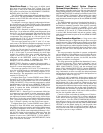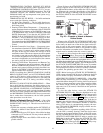
Oil Cooler — The oil for the external gear and the com-
pressor must be cooled while the compressor is running. The
compressor oil cooler is a water-cooled, helical, tube-in-
shell type heat exchanger. A plug valve is manually set to
maintain proper temperatures. Set the valve to maintain a
145 F (63 C) oil sump temperature while the compressor is
running.
The gear oil cooler is a water-cooled, helical tube-in-shell
type heat exchanger. A plug valve is manually set to main-
tain proper temperatures. Set the valve to maintain the oil
temperature leaving the cooler at 130 F (54 C) while the com-
pressor is running.
Remote Start/Stop Controls — A remote device, such
as a time clock with a set of contacts, may be used to start
and stop the chiller. However, the device should not be pro-
grammed to start and stop the chiller more than 2 or 3 times
every 12 hours. If more than 8 starts in 12 hours occur, the
Excessive Starts alarm is displayed, and the chiller is pre-
vented from starting. The operator must reset the alarm at
the LID in order to override the starts counter and start the
chiller. If the automatic restart after a power failure (AUTO
RESTART OPTION ) is not activated (disabled) when a power
failure occurs and the remote contact is closed, the PIC con-
trol activates an alarm because of the loss of voltage.
The contacts for remote starting are wired into the starter
at terminal strip TB5, terminals 8A and 8B. See the certified
drawings for further details on contact ratings. The contacts
must be dry (no power).
Spare Safety Inputs — Normally closed (NC) digital
inputs for additional field-supplied safeties may be wired to
the spare protective limits input channel in place of the factory-
installed jumper. (Wire multiple inputs in series.) Opening
any contact results in a safety shutdown and LID display.
Refer to the certified drawings for safety contact ratings.
Analog temperature sensors may also be added to the op-
tions modules, if installed. These may be programmed to ac-
tivate an alert on the CCN network, but not shut down the
chiller.
Spare Alarm Contacts — Two spare sets of alarm con-
tacts are provided in the starter. The contact ratings are pro-
vided in the certified drawings. The contacts are located on
terminal strip TB6, terminals 5A and 5B, and terminals 5C
and 5D.
Condenser Pump Control — The chiller monitors
the condenser pressure (CONDENSER PRESSURE param-
eter on the STATUS01 screen) and may turn on the con-
denser pump if the pressure becomes too high whenever the
compressor is shut down. The condenser pressure override
(COND PRESSURE OVERRIDE parameter on the
SERVICE1 screen) is the value that determines this pressure
point. Its default value is 125 psi (862 kPa). If the condenser
pressure is greater than or equal to the condenser pressure
override, and the entering condenser water temperature (EN-
TERING CONDENSER WATER parameter on the
STATUS01 screen) is less than 115 F (46 C), then the con-
denser pump energizes to try to decrease the pressure. The
pump turns off when the condenser pressure is 5psi (34 kPa)
less than the pressure override, or when the condenser re-
frigerant temperature (CONDENSER REFRIG TEMP on the
STATUS01 screen) is within 3° F (2° C) of the entering con-
denser water temperature.
Condenser Freeze Prevention — This control al-
gorithm helps prevent condenser tube freeze-up by energiz-
ing the condenser pump relay. If the pump is controlled by
the PIC, starting the pump helps prevent the water in the
condenser from freezing. Condenser freeze prevention can
occur whenever the chiller is not running except when it is
either actively in pumpdown or in pumpdown lockout with
the freeze prevention disabled.
When the condenser refrigerant temperature is less than
or equal to the condenser freeze point (CONDENSER FREEZE
POINT on the SERVICE1 screen), or the entering condenser
water temperature is less than or equal to the condenser freeze
point, then the condenser water pump (CONDENSER WA-
TER PUMP on the STATUS02 screen) is energized until the
condenser refrigerant temperature is greater than the con-
denser freeze point plus 5° F (2.7° C). If the chiller is in
PUMPDOWN mode and the pump is energized, the PIC ac-
tivates an alarm. If the chiller is not in PUMPDOWN mode
and the pump is energized, the PIC activates an alert. If the
chiller is in RECYCLE shutdown mode, the mode transi-
tions to SHUTDOWN (non-recycle shutdown).
Tower-Fan Relay — This control can be used to assist
the condenser water temperature control system (field sup-
plied). Low condenser water temperature can cause the chiller
to shut down on low refrigerant temperature. The tower fan
relay, located in the starter, is controlled by the PIC to en-
ergize and deenergize as the pressure differential between
cooler and condenser vessels changes. This function pre-
vents low condenser water temperature and maximizes chiller
efficiency. The tower-fan relay can only accomplish this if
the relay has been added to the cooling tower temperature
controller. The tower-fan relay (TOWER FAN RELAY on the
STATUS02 screen) is turned on whenever the condenser wa-
ter pump is running, flow is verified, and the difference be-
tween cooler and condenser pressure is more than 30 psid
(207 kPad) or entering condenser water temperature is greater
than 85 F (29 C). The tower-fan relay is deenergized when-
ever the condenser pump is off, flow is lost, the evaporator
refrigerant temperature is less than the override temperature,
or the differential pressure is less than 28 psid (193 kPad)
and entering condensing water is less than 80 F (27 C).
IMPORTANT:A field-supplied water temperature con-
trol system for condenser water should be installed.
The system should maintain the leaving condenser wa-
ter temperature at 20° F (11° C) above the leaving chilled
water temperature.
The tower-fan relay control is not a substitute for a con-
denser water temperature control. When used with a wa-
ter temperature control system, the tower-fan relay con-
trol can be used to help prevent low condenser water
temperatures and associated problems.
Auto. Restart After Power Failure — This option,
which may be viewed or modified on the CONFIG screen
(the AUTO RESTART OPTION parameter), can be enabled
or disabled. If this option is enabled, the chiller starts up au-
tomatically after a single cycle dropout; low, high, or no volt-
age; and the power is within ±10% of normal. The
15-minute start-to-start timer and the stop-to-start timer are
ignored during this type of start-up.
When power is restored after a power failure, and if the
compressor had been running, the oil pump is energized for
one minute before the evaporator pump is energized. The
Auto. Restart function then continues like a normal start-up.
36


















